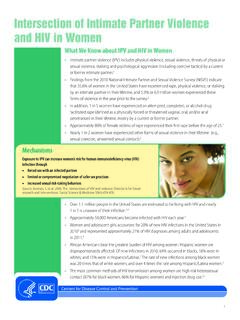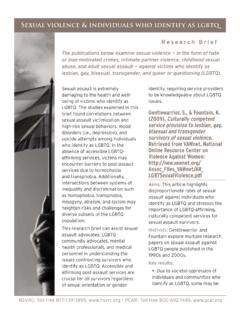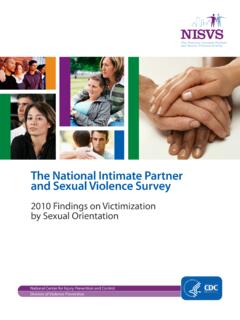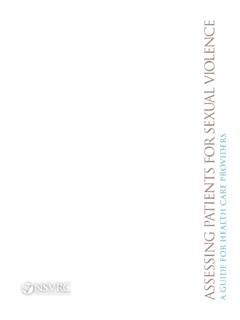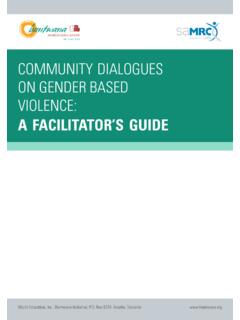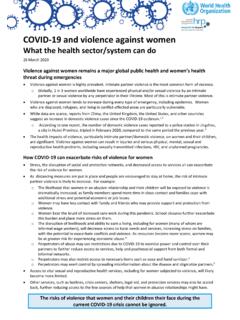Transcription of Kofi Annan, Secretary-General, United Nations, Nobel Peace ...
1 World reporton violenceand healthSUMMARYV iolence cuts short the lives of millions of people across the world each year, and damages the lives of millions more. It knows no boundaries of geography, race, age or income. It strikes at children, young people, women and the elderly. It finds its way into homes, schools and the workplace. Men andwomen everywhere have the right to live their lives and raise their children free from the fear of must help them enjoy that right by making it clearly understood that violence is preventable, and byworking together to identify and address its underlying causes. Kofi Annan, Secretary-General, United Nations, Nobel Peace Laureate, 2001 Massacres, forced displacement of populations, discriminatory access to health care in the contexts in whichMSF works, violence , particularly political violence , is often one of the main causes of mortality. The absenceof this category in epidemiological registers often reflects the ambiguity of doctors and experts to authoritiesin power.
2 This report is a welcome break in this wall of Rostrup, President, M decins Sans Fronti res (MSF) International Council, Nobel Peace Laureate, 1999 A stronger commitment to increase global violence prevention efforts is desperately needed. Therefore, I welcome this report very much. For the first time all of the available knowledge has been assembled into onepublication. Civil society, United Nations agencies and governments need to work hand in hand on theimplementation of the recommendations of this Williams, International Campaign to Ban Landmines, Nobel Peace Laureate, 1997As long as humanity continues to rely on violence to resolve conflicts, the world will enjoy neither Peace nor security, and our health will continue to suffer. This report is an important resource for opening our eyesto the reality of violence as a public health problem, and for providing a source of hope for the only when we realize that violence is destroying both our bodies and our souls will we begin tocollectively address its roots and consequences.
3 This report is an important step in that Arias, Former President of Costa Rica, Nobel Peace Laureate, 1987 WHO has made a substantial contribution by providing a global perspective on all forms of violence . Thecolossal human and social cost of violence hitherto has been inadequately addressed as a public health report will raise the struggle against violence to a new level of engagement by health workers and 20 years we in IPPNW have maintained that nuclear weapons and war are the ultimate expressions ofviolence that must be eliminated if we are to bequeath a liveable planet to generations yet Chazov and Bernard Lown, International Physicians for the Prevention of Nuclear War (IPPNW), Nobel Peace Laureates, 1985 World Health OrganizationGenevaISBN 92 4 154562 3 World report onviolence and health:summaryWorld Health OrganizationGeneva2002 WHO Library Cataloguing-in-Publication DataWorld report on violence and health : violence offenses health factorsISBN 92 4 154562 3(NLM classification: HV 6625)Suggested citation:World report on violence and health.
4 , World Health Organization, of Nelson Mandela reproduced with permission from the African National World Health Organization welcomes requests for permission to reproduce or translate its publications, in part or in full. Applicationsand enquiries should be addressed to the Office of Publications, World Health Organization, Geneva, Switzerland, which will be glad toprovide the latest information on any changes made to the text, plans for new editions, and reprints and translations already Health Organization 2002 Publications of the World Health Organization enjoy copyright protection in accordance with the provisions of Protocol 2 of the UniversalCopyright Convention. All rights designations employed and the presentation of the material in this publication do not imply the expression of any opinion whatsoeveron the part of the Secretariat of the World Health Organization concerning the legal status of any country, territory, city or area or of itsauthorities, or concerning the delimitation of its frontiers or mention of specific companies or of certain manufacturers products does not imply that they are endorsed or recommended by theWorld Health Organization in preference to others of a similar nature that are not mentioned.
5 Errors and omissions excepted, the names ofproprietary products are distinguished by initial capital the designation country or area appears in the headings of tables, it covers countries, territories, cities or by minimum graphicsTypeset and printed in Switzerland2002/14683 Stratcom 25 000 ContentsForewordvPrefaceviiViolence a universal challenge1 The public health approach to violence3 Defining violence4 Typology of violence4 Measuring violence5 The impact of violence lives lost and health harmed6 The roots of violence an ecological model9 From analysis to action10 The forms and contexts of violence13 Interpersonal violence13 Young people and violence13 violence against intimate partners15 Child abuse and neglect by parents and other caregivers16 Abuse of the elderly17 Sexual violence17 The dynamics of interpersonal violence18 Self-directed violence19 Magnitude of the problem19 The dynamics of suicide20 Collective violence21 Magnitude of the problem21 Consequences of collective violence22 The dynamics of violent conflict23 What can be done to prevent violence ?
6 25 Individual approaches25 Relationship approaches26 Community-based efforts27 Societal approaches28 Some important gaps28 Recommendations for action31 Conclusion35 References37 ForewordThe twentieth century will be remembered as a century marked by violence . Itburdens us with its legacy of mass destruction, of violence inflicted on a scalenever seen and never possible before in human history. But this legacy theresult of new technology in the service of ideologies of hate is not the onlyone we carry, nor that we must face up visible, but even more widespread, is the legacy of day-to-day,individual suffering. It is the pain of children who are abused by people whoshould protect them, women injured or humiliated by violent partners, elderlypersons maltreated by their caregivers, youths who are bullied by otheryouths, and people of all ages who inflict violence on themselves. This suffering and there are many moreexamples that I could give is a legacy that reproduces itself, as new generations learn from the violence ofgenerations past, as victims learn from victimizers, and as the social conditions that nurture violence areallowed to continue.
7 No country, no city, no community is immune. But neither are we powerless against thrives in the absence of democracy, respect for human rights and good governance. We oftentalk about how a culture of violence can take root. This is indeed true as a South African who has livedthrough apartheid and is living through its aftermath, I have seen and experienced it. It is also true thatpatterns of violence are more pervasive and widespread in societies where the authorities endorse the use ofviolence through their own actions. In many societies, violence is so dominant that it thwarts hopes ofeconomic and social development. We cannot let that who live with violence day in and day out assume that it is an intrinsic part of the human this is not so. violence can be prevented. Violent cultures can be turned around. In my own country andaround the world, we have shining examples of how violence has been countered. Governments,communities and individuals can make a welcome this firstWorld report on violence and health.
8 This report makes a major contribution to ourunderstanding of violence and its impact on societies. It illuminates the different faces of violence , from the invisible suffering of society s most vulnerable individuals to the all-too-visible tragedy of societies inconflict. It advances our analysis of the factors that lead to violence , and the possible responses of differentsectors of society. And in doing so, it reminds us that safety and security don t just happen: they are the resultof collective consensus and public report describes and makes recommendations for action at the local, national and international will thus be an invaluable tool for policy-makers, researchers, practitioners, advocates and volunteersinvolved in violence prevention. While violence traditionally has been the domain of the criminal justicesystem, the report strongly makes the case for involving all sectors of society in prevention owe our children the most vulnerable citizens in any society a life free from violence and fear.
9 Inorder to ensure this, we must be tireless in our efforts not only to attain Peace , justice and prosperity forcountries, but also for communities and members of the same family. We must address the roots of then will we transform the past century s legacy from a crushing burden into a cautionary MandelaPrefaceViolence pervades the lives of many people around the world, and touches allof us in some way. To many people, staying out of harm s way is a matter oflocking doors and windows and avoiding dangerous places. To others, escapeis not possible. The threat of violence is behind those doors well hidden frompublic view. And for those living in the midst of war and conflict, violencepermeates every aspect of report, the first comprehensive summary of the problem on a globalscale, shows not only the human toll of violence over million lives losteach year and countless more damaged in ways that are not always apparent but exposes the many faces ofinterpersonal, collective and self-directed violence , as well as the settings in which violence occurs.
10 It showsthat where violence persists, health is seriously report also challenges us in many respects. It forces us to reach beyond our notions of what isacceptable and comfortable to challenge notions that acts of violence are simply matters of family privacy,individual choice, or inevitable facets of life. violence is a complex problem related to patterns of thoughtand behaviour that are shaped by a multitude of forces within our families and communities, forces that canalso transcend national borders. The report urges us to work with a range of partners and to adopt anapproach that is proactive, scientific and have some of the tools and knowledge to make a difference the same tools that have successfullybeen used to tackle other health problems. This is evident throughout the report. And we have a sense ofwhere to apply our knowledge. violence is often predictable and preventable. Like other health problems, itis not distributed evenly across population groups or settings.










